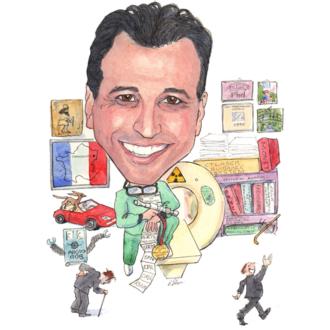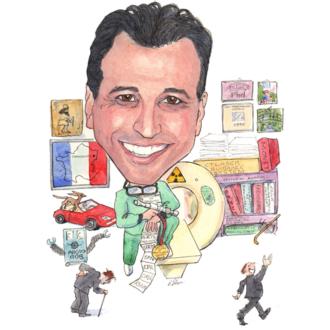
By Lowell S Kabnick
The RECOVERY trial, presented at the 34th Annual Meeting of the Society of Interventional Radiology, addresses the highly debated topic of endovenous laser treatment outcomes compared to those of radiofrequency ablation. Specifically, the trial evaluated a 980nm endovenous laser (Biolitec, East Longmeadow, MA) using a 600 micron bare-tip fibre as opposed to the newly developed ClosureFAST®(RF) system (VNUS Medical, Sunnyvale, California) with a 7F catheter.
There is abundant clinical data comparing the original Closure procedure versus endovenous laser ablation with a bare-tip fibre; however, these studies were primarily focused on efficacy and safety.1,2 While the RECOVERY trial only assessed short-term results, several outcomes were evaluated, including pain, ecchymosis, tenderness, adverse sequelae, clinical severity score, and quality of life. The comprehensiveness of the study was further supported by the prospective, multi-centre, randomised protocol used to generate data for the 87 limbs.
Almeida et al3 reported 100% procedural success for both groups, with the RF group sustaining less postoperative pain, ecchymosis, tenderness and minor complications than the endovenous laser (EVL) group at 48 hours, one week. Additionally, the RF group demonstrated lower Venous Clinical Severity Scores (VCSS) and more optimal Quality of Life (QOL) scores than the EVL group through the initial two weeks.3 Conversely, no difference was noted in any of the endpoints between the two groups in the final postoperative evaluation at one month.3
The investigators of the RECOVERY trial,3 as well as several other thought leaders, support the theory that the initial bruising, tenderness, and pain experienced by patients after undergoing EVL can be attributed to perforation of the vein wall and extravasation of blood into surrounding tissue.4-6 Furthermore, Almeida et al3 assert that ClosureFAST produces less short-term side effects because the controlled and uniform heating of the 7cm electrode during the procedure precludes vein perforations.
Numerous variables of the EVL procedure have been evaluated for their impact on short-term side effects, including wavelength, linear endovenous energy density (LEED), and most recently, covered fibre tips.7-11 Studies, which have focused on differences between 810nm and 1470nm EVL wavelengths, have demonstrated that longer wavelengths produce slightly less short-term side effects than those associated with shorter wavelengths.8,10,11 This is attributed to the absorption characteristics of each wavelength; the shortest 810nm wavelength has a higher affinity for haemoglobin absorption; whereas, the longest 1470nm wavelength has greater propensity for water absorption.7,10,12 Because water absorption is more efficient than haemoglobin in absorbing energy, this may account for a decrease in vein perforations and a reduction in short-term pain and bruising.10,12 However, studies by Maulins and Pannier using the 1470nm diode do not support the decrease in pain.13,14
Linear endovenous energy density (LEED), which is the number of joules delivered per centimetre, has demonstrated influence on the efficacy of laser treatment. A higher LEED (> 80 J/cm) has shown greater success rates in EVL procedures.15,16 However, achieving a high LEED using a high power setting (>10W) with a bare-tip fibr has shown a marked increase in short-term pain and bruising.17 One of the downfalls of the RECOVERY trial is that 12W of power was used to achieve the target LEED. This high power setting likely contributed to the volume of short-term side effects observed with the bare-tip fibre in the study.
Another limitation of the RECOVERY trial was its use of bare-tipped fibres for the EVL procedures. As the RF technology has recently improved, so has the laser fibre technology with the advent of the jacket-tip fibre. This type of fibre features a “jacket” at the distal tip of the fibre, which covers the energy emanating portion, thus preventing the flat emitting face of the fibre from coming in contact with the vessel wall. Bare-tip fibre contact with the vein wall can lead to perforations, resulting in bruising and potential pain.3-6,18.
In a pilot study comparing the two fibre types, each produced a 100% success rate; however, the jacket-tip fibre generated significantly less postoperative bruising and pain (P< .005).17,18 The use of a jacket-tip demonstrated the ability to prevent vein wall perforations; hence, the difference in short-term side effects. These results also add supportive evidence that vein wall contact does not contribute to the mechanism of action of endovenous lasers.17 Alternatively, the thermal reaction created during the delivery of power appears to be the primary mechanism of lasers.17
With this data in mind, a prospective, randomised pilot trial was recently completed to evaluate a 980nm laser using a jacket-tip fibre (AngioDynamics, Queensbury, New York) versus ClosureFAST(VNUS, San Jose, California). In order to determine a difference in treatment outcomes, 85 patients were randomised to undergo either RF (n=50) using the ClosureFAST method or EVL (n=35) with a jacket-tip fibre, utilising a target LEED of 100J/cm at a power of 12W, and continuous pullback.17,19
Postoperatively, all patients wore 30-40mmHg compression hose and took ibuprofen.16 Duplex ultrasound was performed at 72 hours to confirm treatment success, which revealed a 100% closure rate for both groups.17,19
At one week, ecchymosis was graded (0-5) blindly by a nurse not involved in any of the procedures; additionally, analogue pain scores (0-10) were recorded each of the first seven days by every patient.17,19 The pain results were virtually identical for both groups, with average scores for RF reported at 0.804 and the EVL at 0.906.16,18 Similarly, bruising scores for each group were 1.34 for RF and 1.21 for EVL.17,19
This study provides compelling data for the new jacket-tip fibers, providing further evidence that short-term side effects of EVL are caused by perforations from bare-tip fibres. Even at an unfavourably high power setting of 12W, the jacket-tip fibre was able to produce efficacy and interim side effects equal to that of the ClosureFAST method. These results suggest that jacket-tip fibres generate a uniform thermal reaction similar to that generated by radiofrequency. Moreover, the performance of bare-tip fibers in the RECOVERY trial strengthens the argument for jacket-tip fibers, warranting the need for additional head-to-head trials of ClosureFAST compared to jacket-tip EVL with expanded endpoints.
In summary, while the RECOVERY trial provides formidable data for RF versus bare-tip fibers, the most current RF and EVL jacket-tip methods and devices are indistinguishable in efficacy and short-term side effects. With procedure time and tumescent anaesthesia also equivalent, these procedures present no genuinely significant difference to patients, making both radiofrequency and endovenous laser ablation exceptional options for the treatment of venous insufficiency.
References
1. Almeida JI, Raines JK. Radiofrequency ablation and laser ablation in the treatment of varicose veins. Ann Vasc Surg 2006; 20:547-552.
2. Morrison N. Saphenous ablation: what are the choices, laser or RF energy? Semin Vasc Surg 2005; 18:15-18.
3. Almeida JI, Kaufmann J, Gockeritz O, et al. Radiofrequency Endovenous ClosureFAST® versus Laser Ablation for the Treatment of Great Saphenous Reflux: A Multicenter, Single-blinded, Randomized Study (RECOVERY Study). J Vasc Interv Radiol 2009; DOI: 10.1016/j.jvir.2009.03.008.
4. Mundy L, Merlin TL, Fitridge RA, Hiller JE. Systematic review of endovenous laser treatment for varicose veins. Br J Surg 2005; 92: 1189-1194.
5. Proebstle TM, Gul D, Lehr HA, Kargl A, Knop J. Infrequent early recanalization of greater saphenous vein after endovenous laser treatment. J Vasc Surg 2003; 38: 511-516.
6. Min RJ, Zimmet SE, Isaacs MN, et al. Endovenous laser treatment of the incompetent greater saphenous vein. J Vasc Interv Radiol 2001; 12: 1167-1171.
7. Goldman MP, Mauricio M, et al. Intravascular 1320-nm laser closure of the great saphenous vein: a 6- to 12-month follow-up study. Dermatol Surg. 2004; 30:1380-1385.
8. Kabnick LS. Outcome of different endovenous laser wavelengths for great saphenous vein ablation. J Vasc Surg. 2006 Jan; 43(1):88-93.
9. Kabnick LS. Jacket-Tip Laser Fiber Vs. Bare-Tip Laser Fiber for Endothermal Venous Ablation of the Great Saphenous Vein: Are the Results the Same? Controversies in Vascular Surgery, Paris, 2008.
10. Proebstle TM, Moehler T, et al. Endovenous treatment of the great saphenous vein using a 1320 nm Nd: YAG laser causes fewer side effects than using a 940 nm diode laser. Dermatol Surg; 2005 Dec; 31(12): 1678-83.
11. Almeida JI, Mackay EG, et al. Saphenous laser ablation at 1470 targets the vein wall, not blood. 21st American Venous Forum, Phoenix, February 2009.
12. Goldman MP, Detwiler SP. Endovenous 1064-nm and 1320-nm laser treatment of the porcine greater saphenous vein. Cosmet Dermatol 2003; 31:257–62.
13. Maurins U, Rabe E, et al. Prospective Randomized Study of Endovenous Laser Ablation (EVLA) of Great Saphenous Vein with 1470nm Diode Comparing Bare with off –the –Wall Fiber and First Results with Radial Emitting Fiber. 22nd ACP congress, Marco Island, FL. November 6-9, 2008.
14. Pannier F, Rabe E, etal. Results After Endovenous Laser Ablation (EVLA) of Saphenous Veins with a New 1470nm Laser and Influence of Treatment Modifications. 22nd ACP congress, Marco Island, FL. November 6-9, 2008.
15. Timperman PE, Sichlau M, Ryu RK. Greater Energy Delivery Improves Treatment Success of Endovenous Laser Treatment of Incompetent Saphenous Veins. J Vasc Interv Radiol 2004; 15:1061-1063.
16. Timperman PE. Prospective Evaluation of Higher Energy Great Saphenous Vein Endovenous Laser Treatment. J Vasc Interv Radiol 2005; 16:791-794.
17. Kabnick LS. Venous Laser Updates: New Wavelength or New Fibers? 31st CX Vascular & Endovascular Controversies Update, London, April 2009.
18. Kabnick LS. Jacket-Tip Fiber vs. Bare-Tip Fiber for GSV Laser Ablation. Veith Symposium, New York, November 2008.
19. Kabnick LS. Covered Laser Fiber vs. Radiofrequency: Are The Results Similar? The International Symposium on Endovascular Therapy, Hollywood, FL, January 2009.















